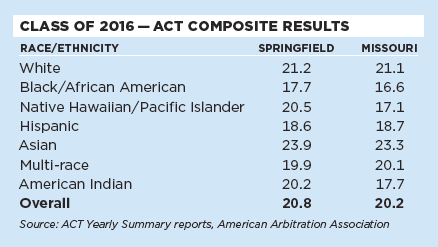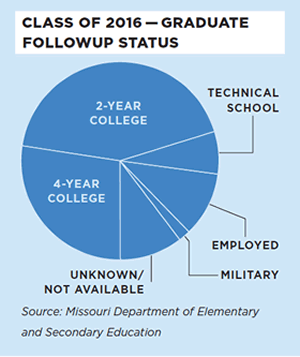EDUCATION

Springfield Public Schools has connected with businesses and community partners to expand options for the district's 25,000 students, but funding challenges remain.
- Community collaboration and support
- Ensure equity of opportunity
- Stable results measures
- The achievement gap
- Instability of funding
Springfield Public Schools' strategic plan 2015-2020 set forth a collective vision for the community and the district's 25,000 students. SPS seeks to engage students, staff and the community to expand our thinking of a high-quality SPS graduate and ensure all students — regardless of background — succeed academically.
BLUE
RIBBONS

Organizations, businesses, faith-based agencies, and nonprofits provide human capital, financial resources, and space as collaborators who support the district's "Every Learner – Every Day" philosophy.
Multiple organizations work to respond to the needs of under-resourced students, providing for unmet needs of food, transportation, mental and physical health, consistent shelter, and access to early childhood education.
And while SPS works to link with additional partners, it nurtures established relationships, including:
- A new partnership between Ozarks Technical Community College, 3M, and SPS will assist middle-school students in considering manufacturing as a career option as they learn how to program, operate, and maintain electromechanical and automated equipment.
- Greater Ozarks Center for Advanced Professional Studies (GO CAPS) has engaged over 250 partners to allow students to shadow and work with professionals.
- SPS hosts LAUNCH, a program to develop high-quality online learning options. This regional collaborative will offer partner districts 1,000 virtual learning seats during the 2017–2018 academic school year.
- The Kennedy Center Any Given Child Springfield grant provides a robust program of arts experiences for every child in SPS in grades K–8.
The district has responded to the red flag noted in 2015 to "commit to equity of resources and a firm belief that where students live within the city should not define their academic opportunities." The district has taken deliberate steps to ensure equity of opportunity and remove barriers to learning, including a re-visioning of summer learning via Explore. The program, now entering its second year, has expanded from 3,000 students impacted to 11,000, providing project-based learning, integrated technology and hands-on experiences including 618 embedded field experiences with 50 community partners.
IGNiTE, the district's three-year technology rollout, has provided modern tools paired with the resources and supports to equip all students with access to engaging, relevant, and personal learning environments, including over 1,500 mobile hotspots for students without Internet access at home. Currently, 20,000 students have personal learning devices through IGNiTE with full deployment completed August 2017.
 Continued expansion of SPS Online provides additional access to course credit recovery or course acceleration. More students are engaging with online learning during the summer months, with nearly 4,000 course registrations during Explore 2017, up from 1,947 a year earlier.
Continued expansion of SPS Online provides additional access to course credit recovery or course acceleration. More students are engaging with online learning during the summer months, with nearly 4,000 course registrations during Explore 2017, up from 1,947 a year earlier.
 With continued expansion of Parents as Teachers, SPS boasts the largest program in the country.
With continued expansion of Parents as Teachers, SPS boasts the largest program in the country.
Springfield continues to have stable results measures. ACT results for the graduating class of 2016 show an average composite score of 20.8 for Springfield Public Schools, above the state's 20.2. April 2015 began the statewide ACT assessment given to all juniors in the state of Missouri.
SPS also checks in with graduates 180 days after graduation. Of the graduating class of 2016, 77.3 percent of students attend 2- and 4-year colleges in addition to technical schools. Another 12.6 percent of students are enlisted in the military or employed.
RED
FLAGS

The achievement gap has been listed or referenced in the education section of each Community Focus Report since 2011. While strides have been made to address economic disparities, achievement gaps still exist for students of color.
Participation in the Lumina Foundation Community Partnership Attainment Grant created awareness of a "program rich, systems poor" approach. Newly aligned partnerships with Springfield's NAACP and Alliance for Leadership, Advancement, and Success (ALAS), along with targeted programming through Ujima and Sí Se Puede, demonstrate a renewed commitment and a shift in approach.
Research has shown that mentoring provides positive role models who can impart critical social skills and positive academic attitudes that assist under-resourced students in overcoming race-based and socioeconomic obstacles. Groups such as Elevate Lives and Mentoring Matters have plans to grow their mentoring programs to help in this area.
For over a decade, insufficient funding has been cited as a concern in this report.
The board and administration of Springfield Public Schools reached a major milestone at the end of 2016 in confronting this issue by ratifying a comprehensive facility master plan.
The next step is acquiring the necessary funding to deliver that plan. In April 2017, the district garnered over 14,000 yes votes for a 24-cent debt service levy increase to fund a $189 million bond issue that would have allowed phase one of the plan to be delivered. The vote count represented a majority of support from the community (51%) but fell short of the statutorily required 57.14 percent for passage. The district is now back in a research and development phase that includes focus groups and data collection from the community to determine what adjustments are necessary to increase support.
The state of Missouri did pass a budget that included full funding of the foundation formula for the first time in many years. These funds can be used for many district identified needs and may also allow for a massive expansion of early childhood education classrooms as early as 2018–19.
Success will require intentional, aligned focus on all players in a student's education — students, parents, staff, and community. It will require the will to do what we know works, and, equally as important, to stop doing what doesn't. It will require us to define measures and hold each other collectively responsible for their attainment.
Community Voices
Students at Missouri State University gathered input from the Springfield citizens via Padlet. Respondents voiced concerns about secure financial support for public schools.
"Preparing students for success demands that we have the courage to change. We cannot rely on what has worked in the past because the needs of students and employers are constantly evolving."
— JOHN JUNGMANN
SUPERINTENDENT,
SPRINGFIELD PUBLIC SCHOOLS
For current information on education in the area, visit CARES Engagement Network.

